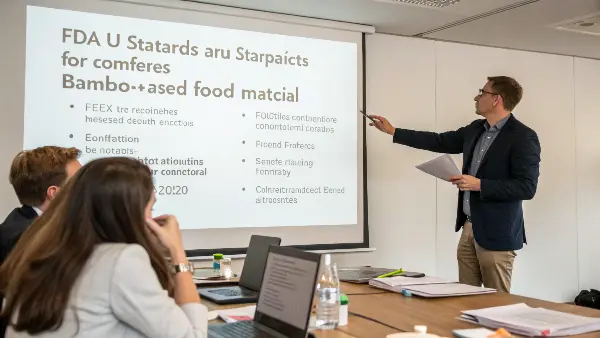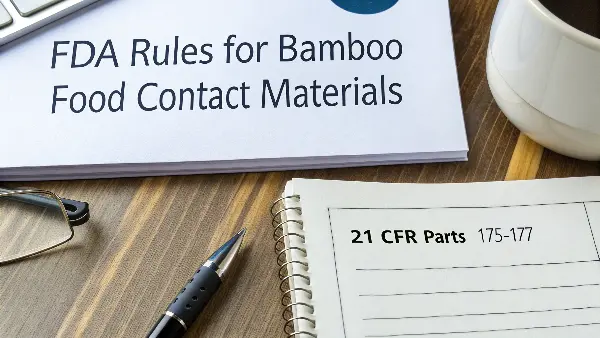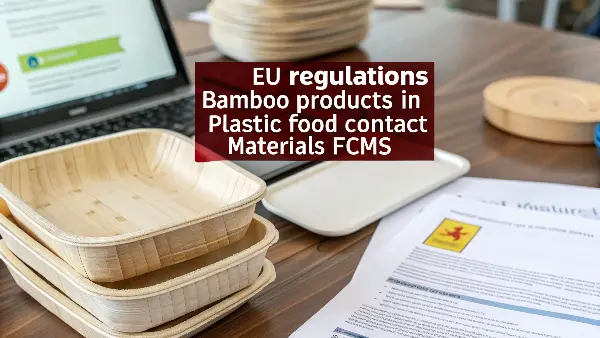Are you looking to import bamboo food contact products but feeling overwhelmed by the maze of regulations? You’re not alone. Many businesses get tripped up by the different rules in the US and EU, leading to costly customs delays, rejected shipments, and even brand damage. Understanding these rules isn’t just about compliance; it’s about protecting your investment and your customers.
The key difference is how each region views bamboo mixed with plastic. The US regulates bamboo food contact materials (FCMs) under general safety rules, often treating solid bamboo like wood. The EU, however, has much stricter, specific regulations targeting bamboo mixed with plastic (like melamine) due to high risks of migrating harmful chemicals like formaldehyde. Importers must verify compliance for each market separately to avoid importing products that are illegal in the EU.

It’s easy to see all bamboo products as a single category, but regulators don’t. The difference between a solid bamboo cutting board and a "bamboo fiber" cup is massive from a chemical safety and legal standpoint. This distinction is at the heart of the regulatory divide between major markets. To succeed, you need to dig deeper into what a product is actually made of and which rules apply. Let’s break down exactly what you need to know for each market.
What Are the FDA’s Rules for Bamboo Food Contact Materials?
Thinking about launching your bamboo product line in the United States? It can seem straightforward, but the FDA’s lack of specific rules for bamboo can be a trap. Assuming your product is fine simply because "bamboo" isn’t mentioned in the regulations can lead to serious compliance issues if a safety problem is ever discovered. It’s crucial to understand what the FDA actually expects.
The FDA does not have a specific regulation for solid bamboo food contact materials; they fall under the general requirement that FCMs must be safe and suitable for their intended use. This means they cannot transfer harmful substances to food. If the bamboo product contains adhesives, coatings, or is a composite with plastic, those added components must comply with specific FDA regulations, such as 21 CFR Parts 175-177.

The FDA operates on a principle of general safety. The responsibility falls on the manufacturer and the importer to guarantee that the final product is safe. I once worked with a client who was confident about their new bamboo cutting boards for the US market. The problem wasn’t the bamboo itself, but the industrial-grade adhesive used to laminate the strips together. It wasn’t food-grade and contained chemicals that could leach. We caught it just in time, but it highlights that you must look beyond the main material and examine every component.
The "Generally Recognized as Safe" (GRAS) Principle
The FDA’s framework relies heavily on the concept that food contact substances must be safe. While bamboo itself does not have a specific GRAS notification for food contact use, a finished article made from it can be considered safe if it is manufactured properly and doesn’t leach harmful components. For solid, untreated bamboo, this is rarely an issue. The focus shifts immediately once you add other substances.
Adhesives, Binders, and Coatings Matter Most
This is where most of the compliance risk lies for US imports.
- Adhesives: If you are importing laminated bamboo products like cutting boards or pressed bowls, the adhesive used to bind the bamboo pieces must comply with FDA 21 CFR 175.105.
- Coatings: Any varnish, oil, or lacquer used to seal the bamboo must comply with the relevant regulations for coatings, ensuring no heavy metals or toxic chemicals can migrate into food.
- Composites: If bamboo fibers are mixed with a polymer (plastic), that polymer must be an approved food contact substance under 21 CFR 177.
What Documentation Should You Ask For?
To protect yourself, you need to build a compliance file. Don’t just take a supplier’s word for it; ask for proof. Here’s a simple breakdown of what you need.
| Aspect | FDA Expectation | What You Need from Your Supplier |
|---|---|---|
| Material Safety | No harmful substances migrate to food. | A Declaration of Conformity (DoC), material safety data sheets (MSDS) for adhesives/coatings. |
| Intended Use | The material is suitable for the food type and temperature. | Clear product specifications and documented intended use limitations (e.g., "not for microwave use"). |
| Good Manufacturing Practices (GMP) | Products are made in clean, controlled conditions. | Evidence of the factory’s GMP compliance or certifications. |
| Legal Sourcing | The wood/plant material is legally harvested. | While not an FCM rule, Lacey Act diligence is a best practice. Request info on the bamboo’s origin. |
Why Is the EU So Strict About Bamboo in Plastic FCMs?
Have you seen the EU market alerts and product recalls for "bamboo-ware" and wondered what’s going on? After all, bamboo is marketed as a natural, eco-friendly material. This confusion can easily lead an importer to purchase products that are illegal in the EU, risking seizure of the entire shipment and significant financial loss. Understanding the science behind the EU’s strict stance is critical.
The EU is strict because many "bamboo" products are plastic composites, typically melamine resin mixed with bamboo powder filler. These materials have a high risk of leaching unsafe levels of formaldehyde and melamine into food, especially when used with hot or acidic contents. Under the EU’s plastics regulation (EU) No 10/2011, bamboo flour is an unauthorized additive, making these products illegal to sell in the EU.

This issue became a major focus after coordinated testing across EU member states found widespread non-compliance. I’ve had many conversations with clients who showed me colorful, lightweight "eco" plates and cups made from bamboo fiber, hoping to import them. I had to be the one to tell them that these are precisely the items being targeted by customs authorities. It’s a tough but necessary conversation that protects them from making a very expensive mistake. The EU’s position is not against bamboo; it’s against the unsafe combination of bamboo powder and certain plastics.
The Problem with Melamine-Bamboo Composites
The core issue is chemical stability. Melamine-formaldehyde resin is a type of plastic created from two chemicals: melamine and formaldehyde. When this plastic is molded into a cup or plate, it’s generally stable. However, when you mix in bamboo powder or fibers as a filler, it can weaken the polymer structure. This makes the final product more susceptible to degradation, especially when it comes into contact with hot liquids (like coffee or soup) or acidic foods. This breakdown releases the original, unreacted chemicals—formaldehyde and melamine—into the food at levels that can exceed the EU’s strict safety limits.
Regulation (EU) No 10/2011: The "Plastics Regulation"
This is the central piece of legislation. It governs all plastic materials intended to come into contact with food. A key feature of this regulation is the "Union list," which is a positive list of substances that are authorized for use in the manufacturing of plastic FCMs. This list includes monomers, additives, and polymer production aids. Bamboo powder, wood flour, and other natural fillers are not on this authorized list. Therefore, mixing them into plastic FCMs is prohibited.
What Does This Mean in Practice?
The distinction between product types is everything in the EU.
| Product Type | EU Compliance Status | Reason |
|---|---|---|
| Solid Bamboo (e.g., cutting board, tool) | Generally Compliant | Regulated as a natural material like wood. Any adhesives or coatings must comply with relevant laws. |
| Bamboo Fiber + Melamine Plastic (Colorful "bamboo" plates/cups) | Illegal & Non-Compliant | This is a plastic FCM containing an unauthorized additive (bamboo powder). It is illegal to place on the EU market. |
| Bamboo Fiber + PLA/PBAT (Compostable "bioplastics") | Potentially Compliant, but Complex | This is also a plastic FCM. While potentially legal if all components comply, it still requires rigorous testing to prove it’s safe. |
How Can Importers Ensure Compliance and Mitigate Risks?
Now that you understand the different rules, you might be wondering how to prove your products are actually safe and legal. Navigating this without a clear plan is like walking through a minefield. You could waste money on the wrong tests, have shipments rejected for missing paperwork, or end up in a dispute with your supplier. A systematic approach to verification is your best defense against these risks.
To ensure compliance, you must demand comprehensive documentation from suppliers, including a detailed Declaration of Conformity (DoC) specific to EU or US regulations. Crucially, you need third-party lab reports verifying the product is safe for its intended use, with specific tests for chemical migration (formaldehyde, melamine, heavy metals). For the EU, avoid any plastic products containing bamboo filler. A proactive risk assessment is essential.

I always tell my clients to think of themselves as building a legal case for their product’s safety. If a regulator ever comes knocking, you don’t want to be scrambling to find emails or calling your supplier in a panic. You want to be able to confidently hand over a well-organized technical file that proves you’ve done your due diligence. This not only ensures compliance but also builds immense trust with authorities and, most importantly, with your customers.
The Declaration of Conformity (DoC) Is Non-Negotiable
A DoC is not just a simple certificate. It’s a legally binding document where the manufacturer states that the product complies with all applicable laws. A proper DoC should:
- Clearly identify the product it covers.
- List the specific regulations it complies with (e.g., Regulation (EC) 1935/2004 and (EU) 10/2011 for Europe; FDA 21 CFR sections for the US).
- Be supported by technical documentation, including test reports.
- Provide contact information for the manufacturer or their authorized representative.
Demand the Right Third-Party Tests
Your supplier’s DoC should be backed by evidence. Independent lab testing is the best way to verify their claims.
- For the EU:
- For any plastic FCM (like PLA with bamboo), you need overall migration testing and specific migration limit (SML) testing for relevant substances.
- For solid bamboo, testing for heavy metals in the material and any chemicals in coatings or adhesives is wise.
- For the US:
- Testing should be based on the specific polymers, adhesives, or coatings used, following FDA protocols.
Build Your Own Technical Compliance File
Keep all your documentation organized for each product you import. This file is your proof of compliance.
| Document | Purpose | Why It’s Crucial |
|---|---|---|
| Supplier Declaration of Conformity (DoC) | The legal declaration that the product is compliant. | Your first line of defense and a legal requirement in the EU. |
| Full Material Specification Sheet | Details every single component and its percentage. | Proves you know exactly what is in your product. |
| Third-Party Lab Reports | Independent verification of safety and migration limits. | Provides unbiased proof that the product is safe under real-world use conditions. |
| Traceability Records | Connects a specific production batch to its documents. | Essential for managing quality control and handling any potential recalls efficiently. |
Conclusion
Importing bamboo food contact materials successfully requires a dual-track strategy. In the US, the focus is on general safety and ensuring any added components like glues or coatings are FDA-compliant. In the EU, the rules are far stricter: avoid bamboo-plastic composites entirely and demand rigorous documentation and testing for all materials to prove their safety and legality.


